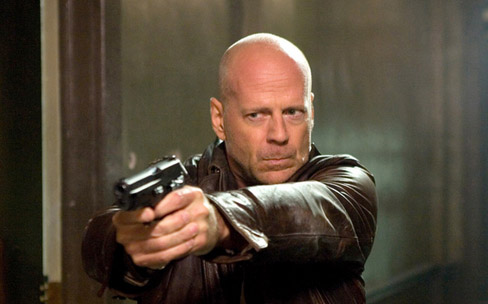
I don’t remember the first time I saw Die Hard. I do know I loved the movie as a kid, which was one of the great action films of my youth alongside The Terminator and T2, Predator, Aliens and Robocop (though I saw most of these as edited network television versions, rather than the R-rated originals). In junior high school I wrote a story in which my high school was taken over by terrorists and my friends and I were the heroes who fought them, crawling through air ducts and using makeshift weapons–an obvious rip-off of Bruce Willis’s first starring vehicle.
I read an article recently (can’t remember where, sorry) that listed the greatest action movies, and on the entry on Die Hard it mentioned how Willis’s John McClane, a blue-collar New York cop who gets caught up in a terrorist attack on an office building in Los Angeles, was a different kind of hero than the bad-ass, unstoppable Herculean killing machines that Arnold (Commando) Schwarzenegger and Sylvester (Rambo II) Stallone tended to play. As the movie begins, McClane is having trouble with his marriage, irritable from having sat through a long flight across the country, and as uncomfortable with the flaky California culture as only a lifelong New Yorker can be. Over the course of the first film, McClane is beaten, stabbed, shot, burned, blown up, and forced to walk barefoot over broken glass–and unlike Stallone or Schwarzenegger, all those wounds add up, to the point where his wife gasps in shock when she sees what’s become of him near the end of the film.
The second film, saddled with the uninspiring title Die Hard 2: Die Harder, was a less-than-memorable affair dealing with a terrorist attack on an airport. It wasn’t until 1995’s Die Hard with a Vengeance that the franchise found its formula. At the beginning of each film, McClane must be down-and-out, despite his heroic actions in the earlier films. He must have a plucky sidekick with whom to trade banter–in the case of Vengeance, the always-fun Samuel L. Jackson, while Reginald VelJohnson filled the role in the first film (Justin “the Mac ad kid” Long has the honor in Live Free or Die Hard). And finally, McClane must beat the bad guys not just with his fists and guns, but with his desperate ingenuity and weary indestructibility.
Willis has allowed McClane to accumulate more and more miles on him with each film. Live Free or Die Hard, directed by Len Wiseman (Underworld and Underworld: Evolution), arrives twelve years after the last sequel. Now bald and wearier than ever, McClane is still working as a New York detective and no doubt getting close to retirement. His only emotional connection is to his daughter, Lucy (Mary Elizabeth Winstead of Sky High and Grindhouse), who is attending Rutgers and, much to McClane’s dismay, hanging out in parked cars with sorta-boyfriends.
Much like Die Hard with a Vengeance, there’s very little of the character development seen in the original film. Within the first twenty minutes McClane is defending a young computer hacker, Matt (Long) from heavily-armed hitmen. When the bosses of these thugs initiate a nationwide cyber-attack that shuts down the entire country, it’s up to McClane and Matt to save the day.
Despite the white-collar nature of the bad guys, Live Free or Die Hard contains some of the most spectacular stunt sequences of the series to date. Each one is as clever and entertaining as anything we’ve seen in the earlier films (though one involving a tanker truck and a jet is so ridiculous the movie almost lost me, if not for Willis’s great performance).
Initially I worried the film would be nothing but a series of stunt sequences without any of the reflection or character interaction we’ve seen in previous films, but it creeps in there, particularly in the banter between Willis and Long. It’s more of a father-son relationship than a typical hero-sidekick routine. There’s an amusing exchange where Matt derides McClane’s archaic tastes in music, and another where McClane makes fun of the hacker for having “dolls” in his apartment (actually collectible action figures, of course, but obviously I’m on Matt’s side on this one).
There’s also a great scene where McClane gives us some insight into why he does what he does. His weary monologue stands in stark contrast to the bombast of the robotic action heroes of many other films.
So yes, a certain weariness pervades this movie, as if it were an elegy for the kind of action film Die Hard arguably created and popularized. Yet it’s still as action-packed and entertaining as any action flick I’ve seen in an age, and its self-awareness is refreshing but not cloying.
I was skeptical when I first heard about the plot, which seemed a little too high-concept for a Die Hard flick. But it works surprisingly well. And if the lead bad guy isn’t quite as charismatic as Alan Rickman’s superb Hans Gruber in the first film or Jeremy Irons’s suave Simon in the third, he’s more hateful than either character and you can’t wait for McClane to take him down a peg.
I don’t know if this will cap the Die Hard series; Willis is no spring chicken, but I’m guessing he might have at least one more flick in him. But if this is the end of the line for John McClane, it’s a great way to go out.
I know exactly what you mean about the fighter jet. I watched this at work and it was touch and go for a few minutes. The part when he finally takes him down a peg was quite exhilarating, in a punch-the-air like an idiot child moment.
Great movie!